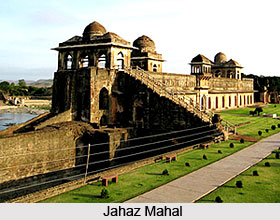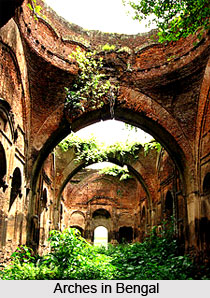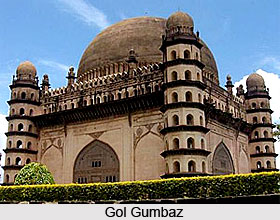 The provincial style of Islamic architecture includes the introduction of the Islamic architectures and their gradual developments in the Indian subcontinent region in the medieval period. These Indo-Islamic architectures in India were introduced during the Islamic rules in different provinces which made tremendous growth especially in this field. These styles were neither Islamic nor Hindu but the fusion of both. The Muslim rulers tried to reshape the Hindu architecture by adding arch, dome and minar to their constructions as well as they also borrowed several Hindu styles and applied to decorate their buildings. Due to this many new features were introduced in their building art. The Muslims rulers during this period mostly created mausoleums, mosques, minarets, forts and palaces.
The provincial style of Islamic architecture includes the introduction of the Islamic architectures and their gradual developments in the Indian subcontinent region in the medieval period. These Indo-Islamic architectures in India were introduced during the Islamic rules in different provinces which made tremendous growth especially in this field. These styles were neither Islamic nor Hindu but the fusion of both. The Muslim rulers tried to reshape the Hindu architecture by adding arch, dome and minar to their constructions as well as they also borrowed several Hindu styles and applied to decorate their buildings. Due to this many new features were introduced in their building art. The Muslims rulers during this period mostly created mausoleums, mosques, minarets, forts and palaces.
There were numerous reasons which conditioned the character of the provincial styles, one of which was the Muslim powers and their practice of arts at Delhi. When a province remained closely associated to the central power which was the Muslim dynasty, their effect on architecture grew strong, while this influence is less noticeable for the distant parts of the country. Another major factor in developing the provincial style was the nature of the indigenous arts which succeeded within the area of the province that flourished due to the association of local artisans. Another reason behind the development of provincial style in India was the migration of experienced foreign craftsmen to the court of different Muslim rulers. They were wonderful artisans and created amazing Islamic architectures and different principles of their native land mixing with Indian provincial culture. Sometimes climatic conditions also played a major role in developing a specific provincial style. In certain parts this climatic conditions imposed several technical differences, one kind of building material being common in some regions and rare in others, all of which naturally affected the character of the building art.
These provincial styles of Islamic architectures developed in Indian subcontinent from Punjab province and gradually expanded to the entire India. They constructed wonderful architectures with the fusion of typical Islamic style of Western Asia and the Hindu culture. The provincial developments of Islamic architecture .
 Indian subcontinent were divided into following categories:
Indian subcontinent were divided into following categories:
Indo- Islamic Architecture in Punjab: Punjab was the first province that experienced the Islamic architecture in Indian subcontinent. These architectures established in the city of Multan. Arab invaded the city from the Sindh region earlier in the eighth century. But the province received a permanent Islamic influence in the tenth century. The Indo-Islamic architecture of Punjab province was mainly of brickworks and produced highly decorated building arts. Their palaces were embedded with brickwork and other wooden elements, mainly their doorways, windows and other hanging balconies. These buildings were constructed in Islamic styles with the fusion of Hindu culture.
Indo- Islamic Architecture in Bengal: In the thirteenth century Arabs invaded the Bengal province and introduced their architecture for the first time in this region. These Muslim rulers constructed several new cities fortresses, palaces, free-standing victory-towers, citadels, immense land bridges and embankments, etc in this province that included present day Bangladesh and West Bengal in India. These architectures were maintained for a period of two hundred and fifty years.
They created the buildings with the locally available building materials combining the regional styles with the typical Muslim features such as domes, arches, the minaret and the mihrab. This amalgamation resulted into a new and improved technique named as Indo-Islamic architecture, enriched with regional building tradition in Bengal.
Indo- Islamic Architecture in Gujarat: Early in the fourteenth century, Gujarat developed the Islamic style of architecture. When Khalji dynasty of Delhi established their Governors in this province, they started to build their architectures for the first time. They constructed and developed their Islamic architecture until the independent rule of the Ahmad Shahi dynasty declined, and absorbed into the empire of the Mughals in the sixteenth century. They constructed their several mosques, tombs and other buildings with the amalgamation of Hindu culture.
 Indo- Islamic Architecture in Malwa: Malwa province experienced the Indo-Islamic architecture in the late medieval period with the invasion of Muslim invaders. This province which included the cities of Dhar and Mandu also experienced a large number of Islamic architectures during the Muslim dynasty. Initially they constructed new buildings on the ruins of Hindu and Jain temple materials. Gradually they developed their own style in building art of Islamic culture. Their skilled artisans constructed the buildings to its distinctive appearance and decorated wonderfully in which colour played an important role in their architectural scheme. They obtained this colour sequence partially by the use of various coloured stones and marble, and partially by means of encaustic tiles and used sand stone, marbles and semi precious stones for the construction of the buildings.
Indo- Islamic Architecture in Malwa: Malwa province experienced the Indo-Islamic architecture in the late medieval period with the invasion of Muslim invaders. This province which included the cities of Dhar and Mandu also experienced a large number of Islamic architectures during the Muslim dynasty. Initially they constructed new buildings on the ruins of Hindu and Jain temple materials. Gradually they developed their own style in building art of Islamic culture. Their skilled artisans constructed the buildings to its distinctive appearance and decorated wonderfully in which colour played an important role in their architectural scheme. They obtained this colour sequence partially by the use of various coloured stones and marble, and partially by means of encaustic tiles and used sand stone, marbles and semi precious stones for the construction of the buildings.
Indo- Islamic Architecture in Bijapur: This city came under Muslim rulers in the medieval period. Allaudin Khilji was the founder of the Islamic architecture in the Bijapur province in the 13th century. Later this city experienced several other styles of Islamic architecture with the gradual change of dynasties like the Bahamani Empire and Adil Shahi dynasty from 13th to 17th century respectively. The golden period of Indo-Islamic architecture in Bijapur was the period of Adil Shahi dynasty. These rulers concentrated their energies on architecture and their related arts. Each member of this dynast developed his predecessor`s architectural projects in number, size or magnificence. They constructed their buildings in three different ways-mosques, tombs, and palaces. They also created several Citadels, palaces, gardens, and pavilions and developed the city to its political, cultural and territorial peak.
Indo- Islamic Architecture in Kashmir: The Islamic architecture of Kashmir is known for its famous woodwork, beautiful gardens and wonderful mausoleums to the holy mosques and shrines. These all represent the previous glorious saga of Islamic architectures in the valley. Major wooden constructions in Kashmir were done by deodar trees in the earlier years of the Muslim regime but later apart from the wooden architectures, Mughals also tried to establish stone buildings in that province.






































